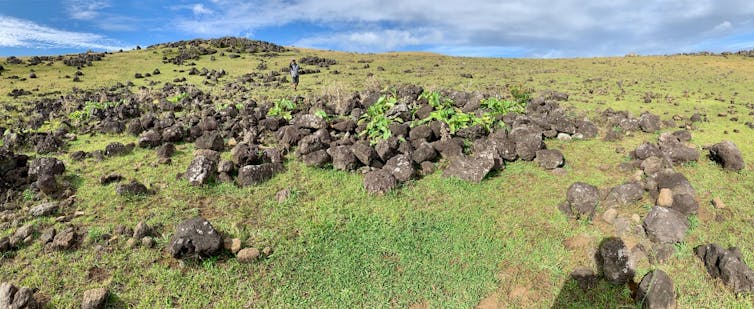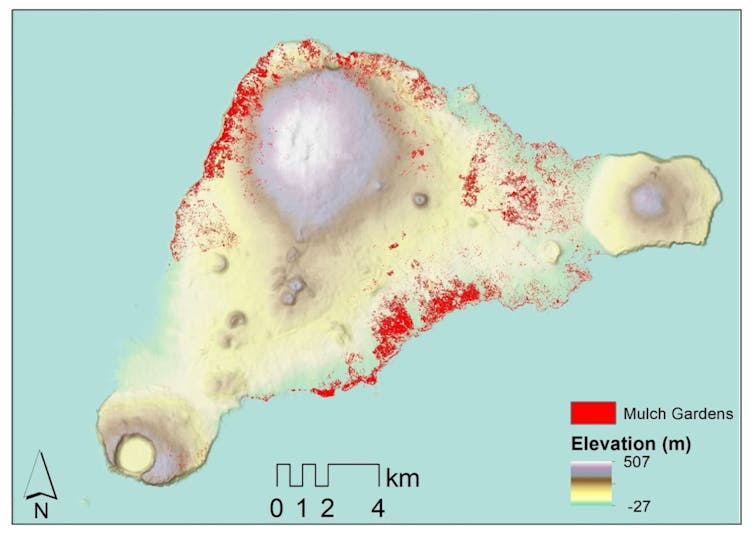
Carl Lipo
Carl Lipo, Binghamton University, State University of New York
Conventional wisdom holds that the island of Rapa Nui, also known as Easter Island, once had a large population that crashed after living beyond its means and stripping the island of resources. A new research study my colleagues and I conducted has struck another blow to this notion by using artificial intelligence to analyze satellite data about piles of rocks on this tiny island in the middle of the Pacific Ocean.
Our study looked at rock gardens, a form of subsistence farming, and determined that the island – just 15.3 miles (24.6 km) long by 7.6 miles (12.3 km) at its widest point – likely never held many more than the 3,000 or so people European explorers encountered in 1722.
The conventional wisdom grew out of speculation about another set of stone structures on the island: the iconic massive statues, called moai, that ancestors of Rapanui people carved. The statues tower as high as a three-story building and weigh up to 70 tons. There are nearly 1,000 of them across the island.
For an archaeologist, the mystery of what led people to invest so much time and energy in building these colossal figures begs for an explanation. For the past 24 years, my colleagues and I have been searching for one.
Some of the earliest European visitors assumed that the island must have hosted a much larger population at one point to account for the number and magnitude of the moai. This assumption has been repeated for generations and forms the basis of a collapse narrative.
The collapse story holds that the island must have once had tens of thousands of inhabitants needed for the labor involved in carving and transporting the massive statues. Such a large population was not sustainable, and ultimately shortfalls in food resulted in starvation, warfare and even cannibalism. Consequently, the population plummeted to the meager numbers observed by the early European explorers.

AP Photo/Karen Schwartz
In our previous studies of the island my colleagues and I asked ourselves, if there were so many people living on the island at some point before European arrival, where is the evidence? We undertook a new study to examine whether such a large population was possible, given how Rapanui people used rock gardens to grow much of their food. From our evaluation of the available data, our best estimate is that there were never more than 3,000 to 4,000 people, and they lived sustainably on the island.
What rocks say about farming
In this study, we examined the archaeological record of how the Rapanui used rock gardening to grow their main crop, the sweet potato. Rock gardening is a form of cultivation in which broken pieces of bedrock are added to the soil to enrich it. Extensive rock garden cultivation plots are found across the island and would have provided a critical food source augmented by marine resources.
Previous studies have noted the extent of these gardens and concluded that these efforts might have supported up to 16,000 people. Our fieldwork, however, found that many of the areas that this study identified as rock gardens were misidentified. So we needed to conduct a more detailed analysis to get a better estimate of rock gardening, which would give us a more reliable source of information about maximum possible population sizes.
We combined fieldwork with new analyses of satellite imagery. During our fieldwork, we looked on the ground for clear examples of rock gardening. We knew we were at locations of rock gardening when we found patches covered with rocks in places that could not be easily explained as the result of erosion. Obsidian artifacts among the rocks confirmed that the areas were used for cutting and processing sweet potatoes. Often, these areas have another root crop, taro, growing in them even today. We also identified places that might resemble rock mulch gardens but were just bedrock outcrops or random scatters of cobbles and boulders.
We then acquired WorldView-3 satellite imagery for the entire island. The WorldView-3 satellite collects high-resolution visible light photos of the Earth’s surface and images that record shortwave infrared information. Shortwave infrared includes wavelengths that range between 900 nm and 2,500 nm, longer than are visible to the human eye. Shortwave infrared is helpful for distinguishing materials that look identical to the unaided eye. In particular, shortwave infrared is sensitive to differences in moisture, an essential attribute of productive agricultural fields.
Using our field data, we trained machine learning models to distinguish rock mulch gardening areas from those that are not. Machine learning generates an algorithm that can detect subtle differences – and can do so repeatedly and systematically. In this way, we could examine nearly the entire island quickly and without spending years doing field mapping.

Dylan Davis, CC BY
Our analyses dramatically reduced the island’s total area that can be associated with rock gardening, from a range of 1.6 to 8.1 square miles (4.3 to 21.1 square kilometers) down to 0.29 square miles (0.76 square kilometers). When we entered estimates for the productivity of these areas, our calculations showed that the maximum number of people this form of cultivation can support is about 3,000, quite similar to the conclusions we reached with other sources of information.
Resilience rather than hubris
Over the past 20 years, researchers have generated significant new evidence about the archaeological record of Rapa Nui, contributing to reframing the island’s narrative away from the idea of collapse. For example, studies from my team demonstrate that the statues were moved in a walking fashion from the quarry to their final locations on platforms called ahu. We have also tackled the question of how the islanders placed giant multiton hats called pukao on the tops of these statues.
However, the idea that there were much larger numbers of people on the island remains embedded in the academic and popular literature. The persistence of this idea has consequences outside of the field of Rapa Nui archaeology. Despite archaeological evidence to the contrary, it is not uncommon, for example, for ecologists to use Rapa Nui as a case study of so-called Malthusian demographics, where the population is assumed to have reached a massive peak that momentarily outstripped the island’s resources and triggered an ecological catastrophe.
While my colleagues and I agree that it is essential to be concerned about the potential for exploitation of natural resources, catastrophe is not the only possibility. Human history offers many examples demonstrating how it is possible to live sustainably despite constraints.
On Rapa Nui, we have learned that its people did not experience a population collapse before the arrival of Europeans but instead succeeded due to their ingenuity. Rapanui people found clever ways of adapting to the island and practiced sustainable farming to support themselves. This research project adds details about the capacity of rock gardens to grow food and support the population of the island.

Carl Lipo
Our increasing understanding of the island has critical implications for the future. In learning how to thrive in a limited environment, society can adopt strategies used by people in the past. The archaeological record of Rapa Nui points to the idea that efforts that bring communities together in cooperative and competitive ways, such as moai carving and transport, lead to greater resiliency in times of shortfall.
In the end, the history of Rapa Nui is not a cautionary tale but a source of inspiration that may be key to humanity’s future.![]()
Carl Lipo, Professor of Anthropology and Associate Dean for Research, Binghamton University, State University of New York
This article is republished from The Conversation under a Creative Commons license. Read the original article.























































